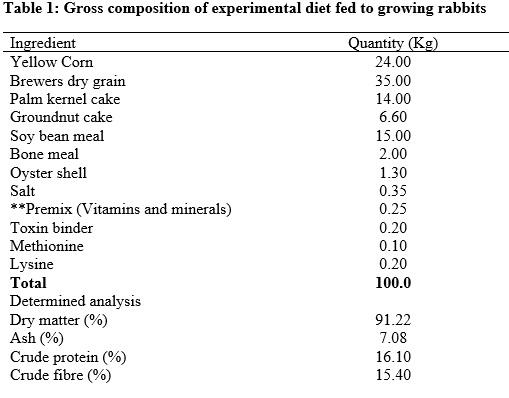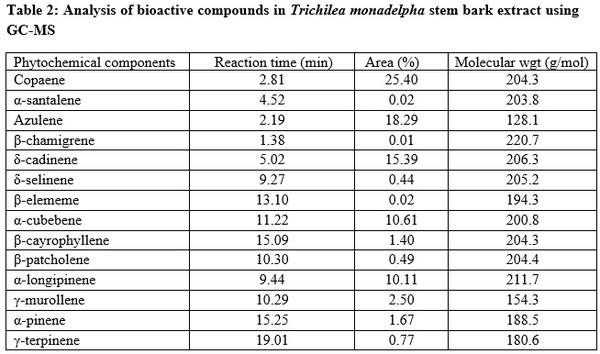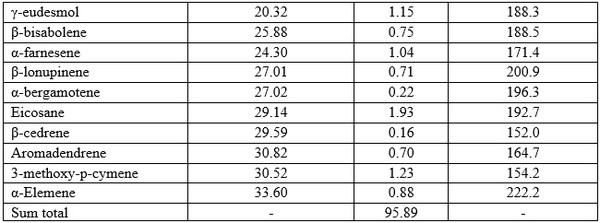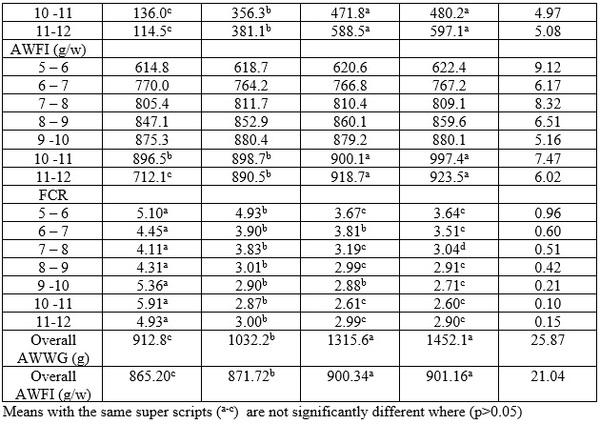Efficacy of Trichilia Monadelpha Stem Bark Extracts on the Growth Performance of Growing Rabbits






International Poultry Production Magazine (2013). Phytogenics –be one step ahead with plant derived feed additives. International Poultry Journal, 24 (8): 8-9.
International Dairy Topics Magazine (2000). The use of plant extracts to support growth in early calfhood. International Dairy Journal, 18 (5): 11-13.
Musa, B., Alagbe, J.O., Adegbite Motunrade Betty, Omokore, E.A. (2020). Growth performance, caeca microbial population and immune response of broiler chicks fed aqueous extract of Balanites aegyptiaca and Alchornea cordifolia stem bark mixture. United Journal for Research and Technology, 2(2):13-21.
Shittu, M.D and Alagbe, J.O. (2020). Phyto-nutritional profiles of broom weed (Sida acuta) leaf extract. International Journal of Integrated Education. 3(11): 119-124
Akintayo Balogun Omolere. M and Alagbe, J.O (2020). Probiotics and medicinal plants in poultry nutrition: A review. United International Journal for Research and Technology, 2(1): 7-13.
Alagbe, J.O., Adeoye, Adekemi and Oluwatobi, O.A. (2020). Proximate and mineral analysis of Delonix regia leaves and roots. International Journal on Integrated Education. 3(10): 144-149.
Alagbe, J.O., Sharma, R., Eunice Abidemi Ojo, Shittu, M.D and Bello Kamoru Atanda (2020). Chemical evaluation of the proximate, minerals, vitamins and phytochemical analysis of Daniellia oliveri stem bark. International Journal of Biological, Physical and Chemical Studies, 2(1):16-22.
Shittu, M.D., Alagbe, J.O., Adejumo, D.O., Ademola, S.G., Abiola, A.O., Samson, B.O and Ushie, F.T. (2021). Productive Performance, Caeca Microbial Population and Immune-Modulatory Activity of Broiler Chicks Fed Different Levels Sida Acuta Leaf Extract in Replacement of Antibiotics. Bioinformatics and Proteomics Open Access Journal 5(1): 000143.
Alagbe, J.O. (2021). Prosopis africana stem bark as an alternative to antibiotic feed additives in broiler chicks diets: Performance and Carcass characteristics. Journal of Multidimensional Research and Reviews, 2(1): 64-77.
Alagbe, J.O. (2021). Daniellia oliveri leaf extracts as an alternative to antibiotic feed additives in broiler chicken diets: Meat Quality and Fatty acid composition. Indonasian Journal of Innovation and Applied Sciences 1(3): 177-186.
Alagbe, J.O (2021). Dietary Supplementation of Rauvolfia Vomitoria Root Extract as A Phytogenic Feed Additive in Growing Rabbit Diets: Growth Performance and Caecal Microbial Population. Concept in Dairy and Veterinary Sciences. 4(2):2021.
Adewale, A.O., Alagbe, J.O., Adeoye, Adekemi. O. (2021). Dietary Supplementation of Rauvolfia Vomitoria Root Extract as A Phytogenic Feed Additive in Growing Rabbit Diets: Haematology and serum biochemical indices. International Journal of Orange Technologies, 3(3): 1-12.
Attia, Y.A., El-Hanoun, A.M., Bovera, F and Monastra, G. (2014). Growth performance, carcass quality, biochemical and haematological traits and immune response of growing rabbits as affected by different growth promoters. Journal of Animal Physiology, 98(1): 128-139.
Dalle Zotte, A., Celia, C and Szendro, Z.S. (2016). Herbs and spices inclusion as feed stuff or additive in growing rabbits diets. Livestock Science, 189: 82-90.
Purnima, A., Prasanna, G.S and Mathuram, V. (2006). Analgesic and anti-inflammatory activity of the chloroform extract of Trichilia connaroides. Indian Journal of Pharmaceutical Science, 68: 231-233.
Ravendra, Kumar, Gaurav, Verma, Prakash, O.M and Pant, A.K. (2011). Head space GC/MS analysis of volatile constituents of Trichilia connaroides extracts and their invitro antiplasmodium activity against Plasmodium falciparum isolates. Research Journal of Phytochemistry, 5(1): 41-47
Agarwal, G., Hore, S.K., Prakash, O and Pant, A.K. (2006). Hypotensive activity of Trichilia connaroides extracts in rats. Journal of Veterinary Pharmacology and Toxicology, 5: 72-73.
Alagbe, J.O., Shittu, M.D and Tanimomo, Babatunde K. (2022). Influence of Anogeissusleio carpus stem bark on the fatty acid composition in meat of broiler chickens. European Journal of Life Safety and Stability 14(22): 13-22.
Muritala, Daniel Shittu., Alagbe, J.O., Ojebiyi, O.O., Ojediran, T.K and Rafiu, T.A. (2022). Growth performance and haematological and serum biochemical parameters of broiler chickens given varied concentrations of Polyalthia longifolia leaf extract in place of conventional antibiotics. Animal Science and Genetics 18(2): 57-71.
Ben, I.O., Woode, E., Abotsi, K.M and Boakye-Gyasi, E. (2013). Preliminary phytochemical screening and in vitro antioxidant properties of Trichilia monadelpha. Journal of Medical and Biochemical Sciences, 2(2): 6-15.
Tseng, A. (1991). Analgelsic effect of the stem bark of Trichilia connaroides. Indian Journal of Pharmacology, 44(6): 765-773.
Pupo, M.T., Viera, P.C., Fernandes, J.R., Silva, M.F and Pirani, J.R. (2002). Teroenoids and steroids from Trichilia spp. Brazilian Journal of Chemical Sciences, 13: 382-388.
Xie, W.L.S., Isman, M.B., Gunning, P., Mackinnon, S., Arnason, J.T., Taylor, D.R., Sanchez, P and Towers, G.H.N. (1994). Biological activity of Trichilia spp and the limonold hirtin against lepidopteran lavae. Biochemical Systems and Ecology, 73: 1304-1308.
Alagbe, J.O (2022). Use of medicinal plants as a panacea to poultry production and food security: A review. Gospodarka I Innowacje 22(2022): 1-12.
Agubosi, O.C.P., Alexander, James and Alagbe, J.O. (2022). Influence of dietary inclusion of Sunflower (Helianthus annus) oil on growth performance and oxidative status of broiler chicks. Central Asian Journal of Medical and Natural Sciences 2(7): 187-195.
Agubosi, O.C.P., Soliu, M.B and Alagbe, J.O. (2022). Effect of dietary inclusion levels of Moringa oleifera oil on the growth performance and nutrient retention of broiler starter chicks. Central Asian Journal of Theoretical and Applied Sciences 3(3): 30-39.
Agubosi, O.C.P., Imudia, Favour Dumkenechukwu and Alagbe, J.O. (2022). Evaluation of the nutritional value of air dried and sun-dried sweet potato (Ipomoea batatas) peels. European Journal of Life Safety and Stability 14(22): 43-51.
Agubosi, O.C.P., Wika, B.K and Alagbe, J.O. (2022). Effect of dietary inclusion of Sunflower (Helianthus annus) oil on the growth performance of broiler finisher chickens. European Journal of Modern Medicine and Practice, 2(5): 1-10.
Alagbe, J.O. (2022). Prosopis africana (African mesquite) oil as an alternative to antibiotic feed additives on broiler chickens diets: performance and nutrient retention. Discovery 58(314): 134 -142.
Ankri, S and Mirelman, D. (1999). Antimicrobial properties of allicin from garlic. Microbes Infection, 1:125-129.
Tesissedre, P.L and Waterhouse, A.L. (2000). Inhibition of oxidation of human low density lipoproteins by phenolic substances in different essential oil varieties. Journal of Agriculture and Food Chemistry, 48: 3801-3805.
Liu, Y., Song, M., Che, T.M., Lee, J.J., Bravo, D and Pettigrew, J.E. (2014). Dietary plant extracts modulate gene expression profiles in ileal mucosa of weaned pigs after infection. Journal of Animal Science, 74: 2050-2062.
Sivropoulou, A., Papanikolaou, E., Nikolaou, C., Lanaras, T and Arsenakis, T. (1996). Antimicrobial and cytotoxic activities of Origanum essential oils. Journal of Agriculture and Food Chemistry, 44: 1202-1205.







.jpg&w=3840&q=75)